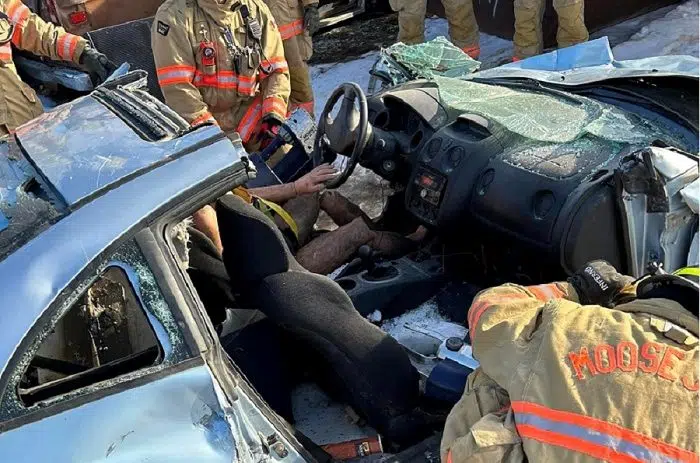By Jay D Haughton
Many people wonder what it would be like to try to extract a person from a vehicle after a major accident.
For the Moose Jaw Fire Department (MJFD), vehicle extrication is a necessary skill to have as first responders.
They had the chance to hone their skills at Silver Star Salvage & Recycling, as a platoon performed vehicle extrication exercises.
MJFD firefighter paramedic Austin Miller says if someone has been in a car accident, they need to be removed from it.
“(The first responder) is trying to get the patient out if they can’t get (themselves) out,” Miller said. “(They) may need to take off doors or the roof and be able to access the patient, give them medical attention, and get them out of the vehicle.”
As for the training, there is a checklist that every firefighter needs to run through before performing a vehicle extrication. The first thing on that checklist is making sure the scene is safe for first responders.
“(They first need to stabilize) the vehicle. (That can be done) depending on how it’s sitting (and whether there’s) cribbing (they) can use … If it’s on its tires, (they) can pop the tires and crib it as well. Once the vehicle is stabilized, (the next step is to) disconnect the battery, so there are no electrical problems that could happen once attending to the patient,” he said.
After that’s complete, the firefighters would then assess what the next course of action will be to get the patient out of the vehicle in the safest way possible.
“(Someone may need) to use the jaws and open the door or cutters and cut one of the ABC pillars to gain access to your patient,” Miller said. “It’s all about teamwork and everyone has a job to work together to get the patient out.”
Miller says his job is creating a purchase point and then operating the jaws of life when he’s on the scene of an accident.
“(The purchase point is) like a smaller hole to allow for the jaw tips to get into it to start prying opening the door,” he added.
This type of training is crucial to firefighters, especially when they’re on the scene of a real-life event, Miller says.
“(It’s important to be) sharp … and (know) what to do in every type of situation depending on (the car’s condition). (That includes) knowing exactly how the tools work and the abilities of the tools so you when you need it, you’re good to go,” the paramedic said.
Miller says operating the jaws of life is a big responsibility.
“All the training we do helps that responsibility to know that you’re going to do the right thing to help the patient or person as soon as (possible) and get them the help they need.”
The vehicle-extraction training was part of the MJFD’s new recruit orientation process.
The MJFD usually refreshes its first responders’ skills a few times throughout the year, twice in the summer and once during the winter.











